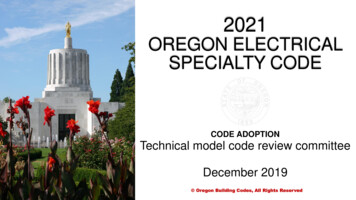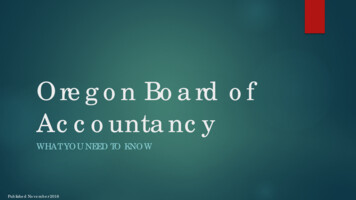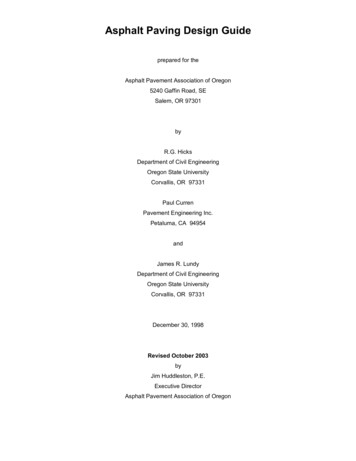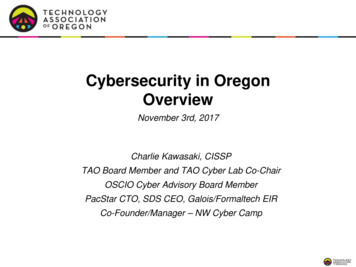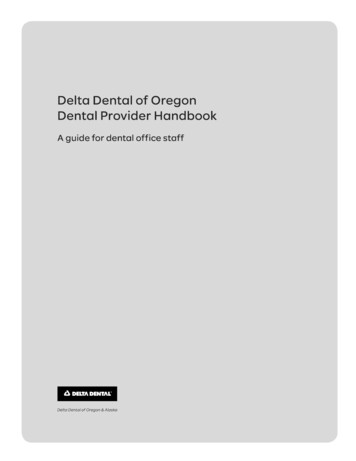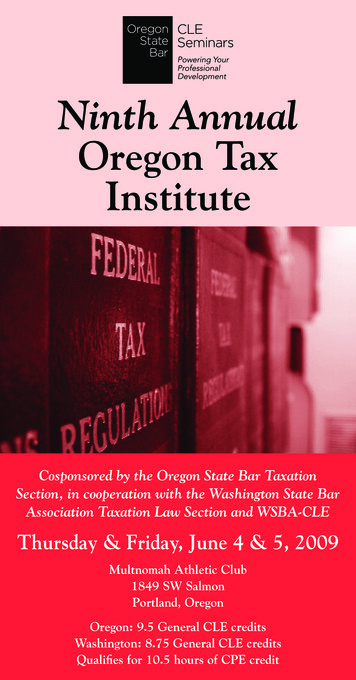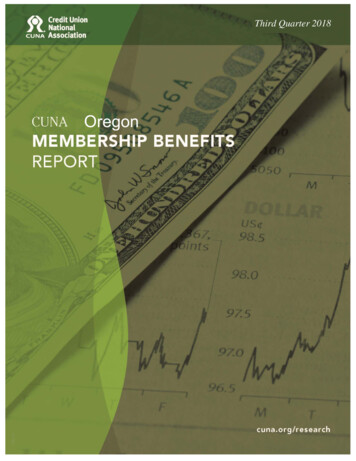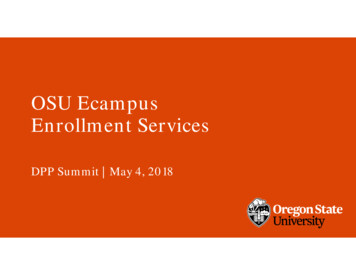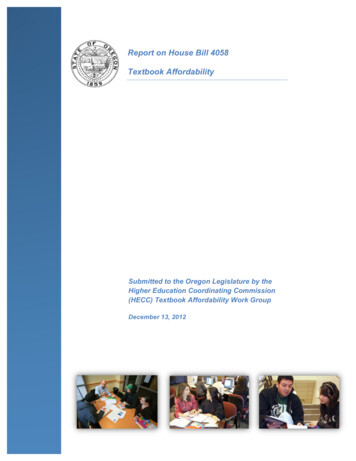
Transcription
Report on House Bill 4058Textbook AffordabilitySubmitted to the Oregon Legislature by theHigher Education Coordinating Commission(HECC) Textbook Affordability Work GroupDecember 13, 2012
Textbook Affordability Work Group MembersKen Brown (Portland State University Bookstore)Charlene Gomez (HECC)Tony Greiner (Portland Community College Library)Al King (HECC)David Krumbein (HECC)James Woods, Ph.D. (HECC)Staff:Alethia Miller (Oregon State University)Sean Pollack (Oregon University System)
TableofContentsCover photos from left to right: courtesy of Southern Oregon University, Western Oregon University, Eastern Oregon University.Report on HB 4058, Textbook AffordabilityTable of ContentsI.Introduction . 4II.Background on HB 4058 . 5III.Textbook Affordability Legislation in Other States . 6IV.Division of Recommendations into Current and For Future Study . 8V.Public Testimony . 9VI.Scope of Recommendations . 11VII.Directed Topics . 13VIII.Current Recommendations . 20IX.Recommendations for Future Study . 24X.Conclusion . 27Sources . 28
IntroductionReport on HB 4058, Textbook AffordabilityI.IntroductionThe Higher Education Coordinating Commission (HECC) was directed in House Bill 4058 to:“[convene] a work group to examine and recommend adoption of strategies for making textbooks more affordable forstudents at all postsecondary institutions in this state.”The group was charged with: Analyzing the successes and shortcomings of ORS 337.500 to 337.506, which address bundling ofinstructional materials; Assessing the effect of Section 112 of the federal Higher Education Opportunity Act of 2008(HEOA) regarding textbook bundling and price disclosure for textbooks and; Examining lists of policy changes that have the potential of reducing textbook prices in Oregon.The Textbook Affordability Work Group (hereafter “the work group”) was convened on July 12, 2012 andheld three public meetings on August 23, September 13, and October 4, 2012. Participation was solicitedfrom students, faculty, librarians, and bookstore managers associated with Oregon’s public, private nonprofit, and private for-profit institutions of higher education, as well as publishers and open educationalresource advocates.In addition to this testimony, the work group conducted research on similar initiatives in other states.Summaries of this research can be found in section IV of this report.Early in the process, it became clear that if the work group conceived of the charge with a narrow definitionof textbooks, either in print form or electronically, it would not be able to address some fundamental costdrivers and make real changes in student costs. The report would be very similar to those produced by theother states where instead of addressing fundamental change, cost reduction strategies were frequently“encouraged” and information was “made available.”To this end, the work group has interpreted the HECC charge to be a broader examination of the costs ofinstructional materials, which includes a wide variety of print and digital materials as well as instructionalservices, e.g., textbooks, exam banks, course management systems, computer mediated tutorials, and lectureslides.Following the Introduction, the report is organized as follows. Section II gives background on the bill thatprompted this report. Section III describes some of the research and recommendations on textbook costsconducted in other states. (It should be noted that Oregon has already implemented many of theserecommendations.) Section IV describes the work group’s rationale for dividing recommendations into parts,those that can be implemented now, and the topics that require additional investigation. This division wasnecessary because of the extremely short deadlines relative to those in other states. Section V summarizes thepublic testimony given in the three hearings. Section VI describes the general incentives problem that canHECC Textbook Work Group Report4
cause inefficient instructional materials choices. Section VII describes the work group’s recommendations onthe topics that members were specifically asked to report on in HB 4058. Please note that some of therecommendations have been embedded in the current recommendations that follow in Section IX and thetopics for future study in Section X.HECC Textbook Work Group Report5
BackgroundonHB4058II.Background on HB 4058HB 4058 was passed by the Oregon Legislature and signed into law on April 11, 2012. The Bill’s purpose andintent was:“to examine and recommend adoption of strategies for making textbooks more affordable for students at allpostsecondary institutions in this state.”1The Higher Education Coordinating Committee empanelled the Textbook Affordability Work Group tofulfill the charge of HB 4058 in July of 2012.In addition to producing a set of recommendations, the work group was charged with studying severalexisting state and federal laws relating to textbooks:Sect. 1(2): The Higher Education Coordinating Commission shall analyze the success and shortcomings of ORS337.500 to 337.5062 and the textbook affordability provisions of the federal Higher Education Opportunity Act of20083 regarding textbook bundling and price disclosure for textbooks.Other specific charges are summarized here:Section (4) specifies that HECC is to “deliberate upon the recommendations” of the work group; the recommendationswill be forwarded to the Higher Ed committee of the Legislature before November 1, 2012. 4Section (5) mandates that “[a]ny strategies recommended in the report must respect the principles of academic freedom,maintain quality of instruction, foster student success and respect copyright law.”Section (6) requires that the recommendations of the HECC working group must be strategies that require actions orrule adoption by the State Board of Higher Education, Board of Education, and strategies that require new or 12reg/measures/hb4000.dir/hb4058.en.html337.500 contains the definitions ("higher education institutions" etc.) http://www.oregonlaws.org/ors/337.500 .337.506 requires that that textbook bundles also be offered separately, and disclosure of price of for separate salehttp://www.oregonlaws.org/ors/337.5062Section 112 of HEOA 2008 is an amendment to Part C of Title I (20 U.S.C.1015) by creating and adding section 133 to the existingpart of 20 U.S.C 1015. An analysis of Oregon compliance with HEOA 2008 is presented below in section dex.html; See also AW-110publ315.pdf3A preliminary Executive Summary for this report was submitted to the HECC, accepted, and passed on to the Legislature onNovember 1, 2012.4HECC Textbook Work Group Report6
extbook Affordability Legislation in Other StatesMany states have investigated relieving student textbook costs in recent years. The recommendations rangefrom increasing awareness among faculty members at postsecondary institutions, to creating textbookbuyback programs at campus bookstores. The various state task forces and commissions have producedrecommendations that employ language of persuasion and information dissemination--e.g. encouragingfaculty to consider the cost of textbooks--while other recommendations offer suggestions for universitycampuses to make specified changes. Due to the wide range of institutions, from community colleges toprivate independent universities, states had difficulty providing recommendations that would benefit allpostsecondary institutions. Below are the summaries of findings and recommendations made in other states:Arizona:Arizona universities reported addressed recommendations by a task force on textbook costs. The results werethat some college bookstores were able to produce a textbook rental pilot program, while others were not.Campuses were able to produce a brochure describing the concerns with purchasing new textbook editions.Florida:The Office of Program Policy Analysis & Government Accountability found that Florida’s postsecondaryinstitutions are using mechanisms to contain textbook costs. These include faculty guidelines that requireprofessors to take student costs into account, and providing access to textbooks at public libraries.Illinois:The Illinois Board of Higher Education in conjunction with the Illinois Community College Board examinedthe feasibility of creating textbook rental programs in universities, finding that rental programs can be aneffective cost-savings measure for low-income students. However, faculty members were concerned thatrental programs would have textbook adoption periods lasting too long, especially when there is concernabout faculty turnover.Kentucky:In Kentucky, the Textbook Commission had an easier time producing recommendations to alleviate K-12textbook costs compared to postsecondary institutions. Due to the extensive market in college textbooks (viapublishers, online, and in-store), much of the material faculty purchased cannot be regulated by the TextbookCommission. “While faculty members select the textbooks and supplementary materials, it is the studentswho actually make the purchases ” (Kentucky Legislative Research Commission, Report 356 pg. vii).Maryland:In Maryland, the textbook affordability summit reported that electronic textbooks, longer edition cycles, andsubscription-based textbook models would ultimately reduce the costs of textbooks. Rental pilot programswere being evaluated and discussed; however, requiring public institutions to develop and implement specifictextbook practices could induce new university costs.HECC Textbook Work Group Report7
Minnesota:The Minnesota Office of Higher Education recommended that faculty members at postsecondary institutionsincrease their efforts to understand how textbooks costs affect their students, and asked that textbook ordersbe placed as quickly as possible. Faculty were also encouraged to not have supplemental material ordered bythe bookstore if it will not be used in class. Faculty were asked to share information about textbook optionswith students. The University of Minnesota has set up a website with a goal to find a point for all open sourcetextbooks nationwide. This website includes reviews, so that faculty who want to explore switching to anopen source text can find and assess them easily. The URL for this site he Associate Student Body Textbook Taskforce at the University of Mississippi wants postsecondaryinstitutions to hold their faculty members accountable when choosing textbooks, and requested thatuniversities produce incentives for faculty members to observe the textbook deadline implemented by thebookstore. One incentive is having faculty evaluation forms assess the professor’s textbook choice and theamount of time given to students.Report of the textbook taskforce in Mississippi identified that major problems concerning textbookaffordability were: selection base, availability, pricing transparency, and turnover between editions.Recommendations included having Institutional Executive Officers sign a unified letter, creating open forumsfor students to discuss textbook options, and offering library reserves.North Carolina:The University of North Carolina (UNC) reported that progress is being made on multiple UNC campuses toensure a guaranteed buyback or rental book offered for required textbooks in introductory postsecondarycourses. Communication between faculty, students, bookstores, and publishers has been the key element tomaking textbooks affordable on campuses.Pennsylvania:The College Textbook Policies Advisory Committee directed their report to the Pennsylvania State Board ofEducation with a series of recommendations for improving the affordability of textbooks statewide. Theyprovided recommendations for the six legislative directives issued to their committee. One recommendationwas to have the Pennsylvania Department of Education develop and host an electronic informationdepository. This would allow faculty members to provide access to textbooks and course materials for free.Another recommendation worked to hold faculty members accountable for their textbook choices byevaluating them on their course material selection, while effectively reporting this information to thedepartment chair. The intent is to ensure that faculty members are held accountable for their decision-makingregarding course materials.Federal Level:At the Federal level, the Advisory Committee on Student Financial Assistance advocated for increasingtextbook resources at libraries, implementing textbook rental programs, and improving financial aid policiesconcerning student supplies and textbook costs. Financial aid measures include allocating emergencyvouchers, loans, and need-based grants; all of these are designed to directly target student textbook costs.HECC Textbook Work Group Report8
udyIV.Division of Recommendations into Current and For Future StudyAs the work group assessed statewide and national responses to textbook affordability concerns it becamevery clear that there were far too many issues to explore in the three months available, and that the scope ofour recommendations would extend from the level of legislative funding requests to the level of campuspolicy.Priority was given to those topics that we were specifically asked to investigate in HB 4058. These areaddressed in the “Directed Topics.” Many of these directed topics were either not feasible or are alreadybeing implemented in Oregon and focused on the final mile (for example, the cost after textbook adoptionshad been made by faculty members), or on a scope that would only be effective on a national scale (forexample, bundling).Our current recommendations focus on the two ends of the decision making process: the choice ofinstructional materials made by the instructor and the timeliness of that decision. These recommendationswere intended to be easy to implement and low cost, relative to some of the more far-reaching topics that werecommend for further study; e.g. changing the fee structure across OUS institutions such that a fraction ofinstructional materials costs are included in fees.HECC Textbook Work Group Report9
PublicTestimonyV.Public TestimonyAt the public meetings held in August, September, and October of 2012, the work group heard testimonyfrom a number of different groups and stakeholders. Some key themes and ideas are summarized here.Publishers: Cengage and the Association of American Publishers (AAP) disputed the assertion that textbookcosts are rising precipitously, citing data showing cost decreases, or increases lower than the Consumer PriceIndex. Both Cengage and AAP noted how quickly the technology surrounding educational materials andpublishing has changed, and that faculty and students are demanding a broad array of services (software,online supplements and applications, for example) that act as cost drivers. Cengage and AAP also noted theneed to focus on quality of materials, as well as price.Libraries: The evidence on library reserves is mixed, currently. Experiments and pilot programs areunderway in Oregon. Some institutions (North Carolina State) report great success. Where librarypartnerships with departments and bookstores are close, there seems to be a good fit. Libraries must bewilling and able to take on the extra administrative and service duties such programs require.Bookstores: Bookstore operators noted that the cost drivers of textbooks and instructional materials werenot of their making. PSU’s bookstore reported that all OUS institutions currently have rental programs inplace, and all are in current compliance with HEOA’s reporting requirements. Finally, bookstores identifiedfaculty non-compliance with textbook ordering deadlines (at the institutional level) as a major controllablefactor in textbook prices.Faculty: The work group was unable to get significant faculty participation at the public meetings. Facultygroups were contacted, but because most of the work was done during the summer, it was difficult to arrangefaculty testimony. Portland Community College was a notable exception, as two faculty members reported onPCC efforts to control textbook costs and to create new open educational resources for Math 115. If nothingelse, the work group learned that local efforts are already underway, and it would be advisable to spend moretime learning about the efforts of campus level individuals and groups to control costs by a variety of means.Students: The work group heard testimony from both individual students and student focused groups, suchas the Associated Students of PSU, OSPIRG, the Oregon Student Association, and others. All students whotestified reported spending between 200 and 500 per term on books, and financial aid awards typically donot cover these costs. All reported that they tried to mitigate those costs where possible by purchasing used,renting, or shopping on secondary markets. But when faculty routinely choose new editions, or do not submittheir selections in a timely manner, their efforts to economize are futile. OSPIRG in particular made specificpolicy recommendations, including regulation of the marketing of textbooks, and the facilitation of moreopen educational resources.Open Educational Resources: The work group heard testimony from Cable Green of Creative Commonsand Jay Cohen of Textflow Media. Dr. Green in particular pointed out how out of step the textbook marketis with other content distribution industries. What is needed, according to Creative Commons, is theHECC Textbook Work Group Report10
equivalent of an iTunes or Netflix or educational content, a new modality that offers access to high-qualitydigital content for a cost that reflects the economics of digital reproduction. Jay Cohen of Textflow Mediagave an enlightening demonstration of a new open source digital content creation model that leveragesexisting Internet and open source architecture to create customizable educational resources.HECC Textbook Work Group Report11
ScopeofRecommendationsVI.Scope of RecommendationsAs noted in the Introduction, restricting our attention to textbooks without taking into account theinterconnections between textbooks, lectures, course management systems, availability of teaching assistants,and evaluation instruments would be counter-productive. Faculty make different choices—textbooks andother instructional materials—depending the availability of other resources.Faculty textbook decisions must be considered as part of a whole system of instructional materials thatincludes: textbooks; exam banks; automatic grading systems; technical support; lecture notes; and classroom technologySome of these are clearly under control of the faculty member, while others are choices made by academicdepartments or the larger institution.If instructors have large classes and no teaching assistants, they are likely to conduct assessments withmultiple-choice tests. If they have access to teaching assistants, they may change this strategy and includeterm papers or class projects. If the university provides access to a high quality course management system(CMS), they may make use of that for homework and content. If the university does not, they may requirestudents to purchase access to one of the commercial course management systems.Institutions make decisions about class size, instructional support, classroom technology, and coursemanagement systems. Instructors use these constraints to construct a student evaluation and content deliveryplan—including textbooks. Students are responsible for any additional costs generated by those plans, forexample, textbooks and online subscriptions.It is the intent of this work group to affirm the right of faculty to make their own choices regardinginstructional materials, but to also call attention to their obligation to consider the final cost to students andthe state as they make those decisions. Our recommendations are directed toward the end goal of creating abetter alignment of incentives for institutions, bookstores, faculty, and students.Incentives in Instructional Materials Choice and UseMisalignment of incentives is a classic institutional problem that repeats itself throughout our economy.Faculty choice of instructional materials is but one example.Perverse incentives focused on just one benefit, at the cost of others, can produce either a lower qualityeducational experience for the same expenditure or higher costs for the same experience. For example:HECC Textbook Work Group Report12
A university-provided Course Management System that the faculty do not use is a waste of resourcesthat increases total costs;The extra 100 required for a text that was chosen because it has marginally better coverage of onetopic is money that could have been better used for one-on-one tutoring;Machine-graded multiple choice tests are rarely the best student assessment, but given the constraintsof large class sizes, no technical support and little grading assistance, this may be the best that can bedone.Misaligned incentives account for the persistent gap between the intention to provide the best educationalexperience, and the unnecessarily high final costs of chosen instructional materials.Maximizing both faculty choice and student benefit without creating a vicious cycle of cost increases wouldrequire several conditions: Better information and motivations for faculty to account for incremental costs, and benefits tostudents in choice instructional materials; Strong incentives for faculty to place textbook orders in a timely fashion; Access to more robust low-cost and open educational resources; Better agreements with publishers and content providers that allow both institutions and publishersgreater certainty and clarity of their anticipated needs for both print and digital materials; and Stronger coordination at the system (OUS) and state level for digital content initiatives.Each of the work group’s recommendations for implementation and further study (sections VIII and IXbelow) are made with a view toward creating or encouraging these conditions.HECC Textbook Work Group Report13
DirectedTopicsVII.Directed Topicsa. HEOA 2008A renewal of the Higher Education Act of 1965, the Higher Education Opportunity Act of 2008 contained aprovision for reducing textbook costs by making more information on editions and prices available tostudents.Sec. 112 of the HEOA 2008 Concerns “Textbook Information”‘‘(a) PURPOSE AND INTENT.—The purpose of this section is to ensure that students have access to affordablecourse materials by decreasing costs to students and enhancing transparency and disclosure with respect to theselection, purchase, sale, and use of course materials. It is the intent of this section to encourage all of the involvedparties, including faculty, students, administrators, institutions of higher education, bookstores, distributors, andpublishers, to work together to identify ways to decrease the cost of college textbooks and supplemental materials forstudents while supporting the academic freedom of faculty members to select high quality course materials forstudents.”HEOA 2008 contains a number of provisions to encourage transparency in pricing, and (un)bundlingoptions, similar to OR 337.506Perhaps most interesting for this work group are the provisions that mandate: disclosure of the price for the college bookstore, and the retail price of the item for the general public disclosure of the ISBN for all recommended and required materials (presumably to enable searchingfor the same edition from online vendors, resellers).An informal study of OUS and Community College institutions and their bookstores indicates that timelysubmission of textbook orders (which enables compliance with HEOA Sec.112 provisions) is uneven acrossinstitutions and departments due to a number of factors. These include: A lack of uniform textbook adoption policies; Last-minute faculty hiring and; Few if any means of ensuring faculty compliance with the law.According to the bookstore managers who were consulted as part of this work group’s research, late orderingon the part of faculty is a primary driver of costs.When the required instructional materials are ordered mere days before the start of the term, ISBNs cannotbe published on the bookstore’s website or other publicly available forum in time for students to search forlower cost options. In public testimony, students clearly expressed that they cannot avail themselves of theexisting used and lower-cost textbook markets without sufficient lead-time to research those options.A policy mechanism that can reduce this scale of this cost driver is described in section IX of this report. The work grouprecommends this or a similar mechanism be adopted as policy by the State Board of Higher Education, and recommends adoptionHECC Textbook Work Group Report14
by community colleges through the Oregon Community College Association (OCCA), which provides advisory services toCommunity College Boards.b. BundlingOf the directed topics, bundling was the most difficult to address given the time constraints imposed on thework group, available expertise, and the need to limit the scope of our investigation to Oregon.HEOA 2008, section 112 provides that any publisher who offers textbook “bundles” (two or moreinstructional materials sold as a single unit) must also offer these same materials separately.ORS 337.506 makes the same provision regarding textbook bundles as HEOA 2008. ORS 337.506 furtherprovides that any publisher of textbooks must also disclose the availability of textbook items for separatepurchase, as well as in bundles.Note that in both cases there is no statement about the pricing of the bundles and the separately availableitems. The bundled items typically have a lower price than the sum of the individual components.Bundling like this is most effective, from the seller’s point of view, when purchasers have diverse opinionsabout the value of the bundled materials. In the context of learning materials, this means that it is effective if,for example, some of the students value textbooks very highly and others value workbooks more highly.Publishers are very adept at pricing products and bundles of products. These practices have, in the past, beenfound lawful and not in violation of the of Section 1 of the Sherman Antitrust Act or Section 3 of the ClaytonAntitrust Act, but recent changes in what was being sold may open this practice to new action.Ten years ago, the item being sold was a textbook, or a textbook and a workbook. Each of these items issubject to the first sale doctrine. The publisher’s rights are exhausted after sale to the student. The secondarymarkets and libraries can provide a safety valve, allowing students to purchase used books from someoneother than the publisher, and examine the material on a short-term basis.Modern publishing has moved beyond the first sale doctrine and is now a web of services. Instead ofpurchasing a textbook, students have a licensing agreement that gives them access to the book on-line for sixmonths. Instead of purchasing a workbook, there is another licensing agreement to have access to apublisher-managed CMS. Neither of these are covered under the first sale doctrine, and the traditional safetyvalves of the secondary markets and libraries don’t exist.While there is no clear need for a change to Oregon law, what is required is a party willing to test the legality of bundling in thenew environment of end user agreements on educational services. Such an entity should be sought out.c. Statewide bulk purchasing of textbooksThe task force recommends no legislative action on this matter. The managers of four different collegebookstores attended the September 13 hearing at the State Capitol. When this possibility was brought up, thebookstore managers were unanimous in saying bulk purchasing would not lead to a reduction in finaltextbook costs.HECC Textbook Work Group Report15
Whatever savings could be achieved by buying more copies of a single title for all institutions would be lostbecause of several factors. First, staff would need to be hired to coordinate the orders between the collegebookstores. Second, to get the best discount from publishers, the books would need to be shipped to acentral location. Those shipments would then need to be taken out of the original boxes, counted,repackaged, and re-shipped to their final destination. Returns of unsold books would have to go through asimilar process. Then bills and accounts would need to be reconciled. Whatever savings would be found in abulk purchase would be lost in administration.d. Statewide used boo
In Maryland, the textbook affordability summit reported that electronic textbooks, longer edition cycles, and subscription-based textbook models would ultimately reduce the costs of textbooks. Rental pilot programs were being evaluated and discussed; however, requir
